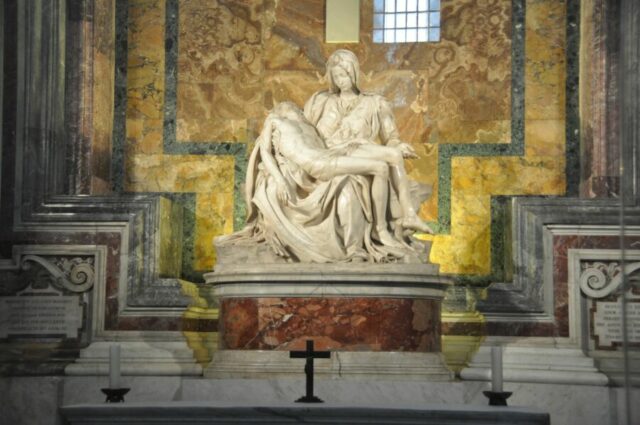When he was just 24 years old, Michelangelo carved the statue that made him famous: His Pietà debuted in St. Peter’s in Rome for the Holy Year of 1500. Thousands of pilgrims filed by and were amazed by what appeared to be a miraculous event carved out of marble yet unfolding before their eyes.
The coronavirus can derail our travel plans…but it can’t stop our travel dreams. And I believe a daily dose of travel dreaming can actually be good medicine. One of the great joys of travel is seeing art masterpieces in person. And I’m currently featuring 10 of my favorites — including this one.

The word pietà means “pity,” and is the name of any work showing Mary tenderly mourning her dead son, Jesus.
Michelangelo, with his total mastery of the real world, captures the sadness of the moment. Mary gazes down on her crucified son. Christ’s lifeless right arm droops down, letting us know how heavy his corpse is. Christ’s bunched-up shoulder and rigor-mortis legs show that Michelangelo learned well from his studies of cadavers. The vulnerability of Christ’s smooth skin is accentuated by the rough folds in Mary’s robe. As Mary supports the body with her right hand, she turns her left hand upward, asking, “How could they do this to you?”
It’s hard to believe that this supple, polished statue is carved from one of the hardest of stones — Carrara marble. Michelangelo didn’t think of sculpting as creating a figure, but as simply freeing the God-made figure already in the marble. He’d launch himself into a project like this with an inspired passion, chipping away to find what God had put inside.
As realistic as this work is, its true power lies in the subtle “unreal” features. Life-size Christ looks childlike compared with larger-than-life Mary. Unnoticed at first, this makes a subliminal impression of Mary enfolding Jesus in her maternal love. Mary — the mother of a 33-year-old man — looks like a teenager, emphasizing how Mary was the eternally youthful “handmaiden” of the Lord, always serving him, even at this moment of supreme sacrifice. Mary always accepts God’s will, even if it means giving up her son.
Mary is a solid pyramid of maternal tenderness. Yet within this, Christ’s body tilts diagonally down to the right and Mary’s hem flows with it. Subconsciously, we feel the weight of this dead Savior sliding from her lap to the ground.
To appreciate the full impact of this scene, Michelangelo hoped you’d view his Pietà from close up, looking up at Mary’s face. Sadly, on May 23, 1972, a madman with a hammer entered St. Peter’s and began hacking away at the Pietà. The damage was repaired, but it changed forever how people interact with this object of beauty. It now sits behind a shield of bulletproof glass and is viewable only from a distance.
This is Michelangelo’s only signed work. The story goes that he overheard some pilgrims praising his Pietà, but saying it was done by a second-rate sculptor from a lesser city. Michelangelo was so enraged he grabbed his chisel and chipped an inscription in the ribbon running down Mary’s chest. It said, “This was made by Michelangelo Buonarroti of Florence.”
This is an excerpt from the full-color coffee-table book Europe’s Top 100 Masterpieces by Rick Steves and Gene Openshaw. Please support local businesses in your community by picking up a copy from your favorite bookstore, or you can find it at my online Travel Store. To enhance your art experience, you can find a clip related to this artwork at Rick Steves Classroom Europe; just search for Vatican.